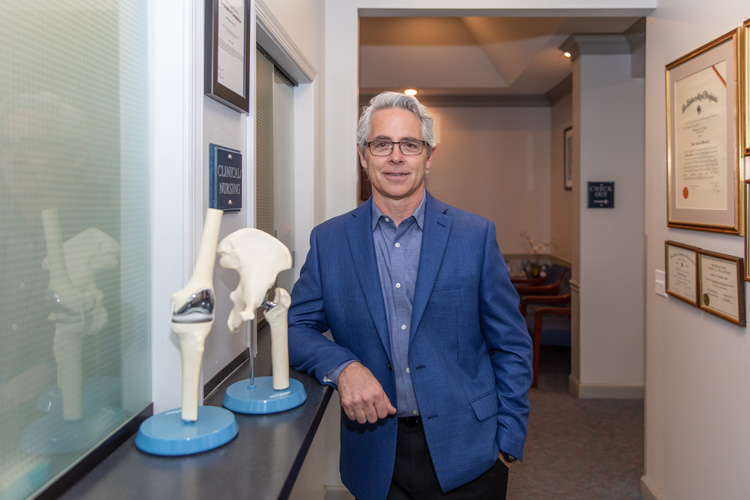
Orthopedic surgeon Dr. Ron Robinson of Vero Beach’s Pro Sports Medicine & Joint Replacement Center and Cleveland Clinic Indian River Hospital has some information you might need to know.
It’s entirely possible, Robinson says, that you could be better off not replacing your aching knee joint with a shiny, new prosthetic version.
Wait a minute.
Doesn’t the American Academy of Orthopaedic Surgeons call total knee replacements “one of the most successful procedures in all of medicine?”
Yes, it does.
And doesn’t the Agency for Healthcare Research and Quality say “more than 600,000 knee replacements are performed each year in the United States?”
That’s true, too.
Nevertheless, according to Cleveland Clinic’s Health Library, “if you have recurring or chronic knee joint pain, you may think joint replacement surgery is your only option for relief. However, you may want to explore several less invasive options first to help maintain mobility as you age” – and that’s where Robinson’s expertise can help.
The human knee is the largest joint in the body and having healthy knees is essential to perform most everyday activities.
The mechanics of the knee joint are surprisingly straightforward.
The knee consists of the lower end of the thighbone (the femur), the upper end of the shinbone (the tibia), and the kneecap (the patella). The ends of these three bones, where they touch, are covered with articular cartilage, a dense, smooth, durable substance that protects the bones and enables them to move easily, without friction, across the adjacent bones.
But that protective cartilage can be worn away or damaged by degenerative arthritis (osteoarthritis) or injury.
If cartilage is still present, and knee pain is not caused by bone rubbing unpleasantly on bone, many knee problems do not require joint replacement to alleviate pain.
According to Cleveland Clinic, “even in the case of osteoarthritis, surgery is not the first choice. Whatever the cause, you’ll want to preserve your joints for as long as you can.”
The success of total knee joint replacements has led to a range of replacement procedures and products, and many patients come in determined to have their joint replaced with something new and high-tech.
“People come here and order them like they’re at Baskin-Robbins,” Robinson says. “‘I want this joint. I want it done this way, and I want this, and I want that.’ Advertising has made this a whole new thing in orthopedics.”
And it’s true, Robinson continues, “in a certain population, total joint replacements are great, and they’ve come a long way [but] … my thought is trying to avoid replacements.
“We’ve got a population of patients here that are just not candidates. They’re too young. Even the best, greatest, latest total joint prosthetics are going to wear out at some point.
“They’re not made to be athletic. They’re not made to be running on them and jumping on them.”
Despite those limitations, Robinson says many people “still try to do all those things on [replacement joints], but they shouldn’t. It causes them to wear out, come loose and break. So, there’s a certain population for whom we can prolong the life of the existing knee and put off replacement for a long time.”
That’s probably not great news for the folks at Stryker Corporation or Smith & Nephew or any of the other total knee replacement manufacturers, but Robinson clearly states “if you don’t have bone disease in the first place, it probably doesn’t make sense” to look to a total knee replacement.
Instead, when possible, Robinson sees greater potential in using a patient’s own, existing ligaments and cartilage.
“I’m talking about regenerating cartilage, transplanting cartilage, filling potholes in cartilage as opposed to replacing the whole joint,” he says.
Robinson is quick to add that some patients are not candidates for these types of procedures. Those who do have severe osteoarthritis may need to go the replacement route.
“Once you’ve worn cartilage down to bone,” he states frankly, “you’re not salvaging that. You’re not going to get away without a total joint replacement.”
Still, with those 600,000 knee replacements being performed each year, Robinson is keenly aware “we’re just so used to knee replacements that people assume that’s what they need.”
But with the proper diagnosis, the proper imaging technology and the proper orthopedic surgeon, many people can successfully put off a total knee replacement procedure for years. Sometimes forever.
Dr. Ron Robinson is with Pro Sports Medicine & Joint Replacement Center and the Cleveland Clinic Indian River Hospital. His office is as 1355 37th Street, Suite 301 in Vero Beach. The phone number is 772-978-7808. His website is at www.prosportsandeliterehab.com.



